Month 11:08, Week 1:7 (Shibi'i/Sukkot), Year Day 303
2Exodus 10/40
Gregorian Calendar: Friday 19 January 2024
Book of Revelation LXIX
The Millennium - Reigning for 1,000 Years
(Revelation 20:1-6)
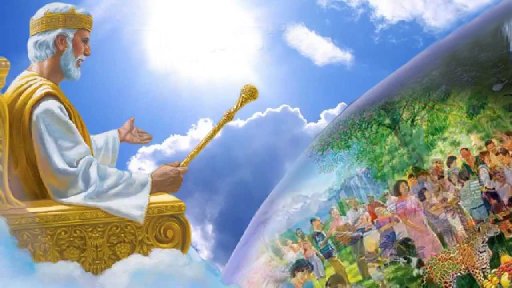
Continued from Part 69
Introduction
Shabbat shalom kol beit Yisrael and Mishpachah and welcome to Part LXIX (69) of our study of the Book of Revelation and to the next three elements (#4-6) of the sevenfold division of Revelation (19:11-21:2). Today we shall be covering the 4th and part of the 5th elements on the fate of Satan when Yah'shua (Jesus) returns and get a first glimpse of the Millennium.
Overview of Revelation 19:11-21
Last week we made a long summary - really a 'grand overview' of the previous week's coverage of Revelation 19:11-21 that covers the Messiah's conquest of the Beast/Antichrist and false Prophet who end up being cast alive in the Lake of Fire. I placed a strong emphasis on the fact that the material we are examining predominantly consists of allegories, metaphors and symbols, and reminded you all to be very wary of taking most what we read literally. The great challenge of the Book of Revelation is to get the correct balance between the abstract and the literal because it is so easy to misintepret. This is why on occasion, as in the last segment, it is necessary to view the same material at least twice and to view it from different angles just as one would with anything three-dimensional. The backside of the moon looks very different from the side that faces us. The same, in some sense, is true, I venture to suggest, of the Book of Revelation. We will need to repeat this exercise many times as we come to the end of the Apocalypse because an accurate assessment of the doctrines taught in it is essential to an understanding of what our hope for the future consists of.
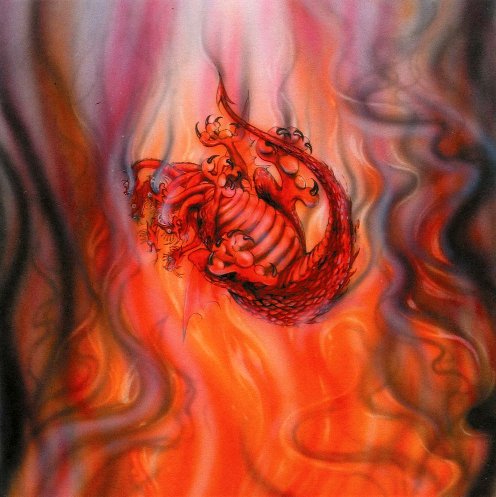 The Beast cast alive into the lake of fire
The Beast cast alive into the lake of fire
The Scope of Chapter 20
Over the next two or three weeks we shall be covering chapter 20 even though, as I have already pointed out, the chapter divisions here (19/20 & 20/21) aren't natural and destroy the sevenfold pattern. The next three parts record:
- 4. The fate of Satan, who is to be bound and cast back into the deep or bottomless pit for a thousand years before being released once more for a short while;
- 5. The First Resurrection and Millennium that includes Satan finally being thrown into the Lake of Fire; and
- 6. The Second or General Resurrection of disobedient believers and unbelievers after the Millennium at which time the Book or Scroll of Life is opened.
4. Satan
(20:1-3) |
Bound and banished to the 'abyss' (deep/bottomless pit)
But for a limited time |
5. Millennium
(20:4-10) |
Saints and martyrs reign (first resurrection)
Satan released for a short season & thrown into the lake of fire |
6. Judgment
(20:11-15) |
General (second) resurrection of 'the rest'
Books/Scrolls and 'book/scroll of life' opened |
REVELATION 20:1-6
Today we will look at only the first six verses of chapter 20 using a messianised New King James Version (NKJV). The text is pretty straight forward with no translation issues to speak of:
"1 Then I saw ('perceived' - CLNT) ['in my vision' - Barclay] a malak (angel, 'messenger' - CLNT, ISRV, AENT) coming down ('descend[ing]' - Moff., CLNT) from heaven (Rev.10:1; 18:1), having the key (Rev.1:18) to the bottomless pit ('abyss' - KNT, NASB, JB, JNT, NEB, HRV, NIV, AENT Moff., Amp.V; 'submerged chaos' - CLNT; 'pit of the deep' - ISRV) (Lk.8:31) and a great ('large' - KNT; 'heavy' - NLT; 'enormous' - JB; 'huge' - JBP, Moff., Barclay) chain in his hand. 2 He laid ('grabbed' - KNT) hold of ('seized' - NLT, JB, NEB, HRV, RSV, NRSV, JBP, NIV, Barclay, ISRV; 'overpowered' - JB, Amp.V; 'gripped' - Moff., Amp.V) the dragon, that ['ancient' - KNT, JNT, RSV, NRSV, CLNT, ESV, NIV; 'primeval' - JB, Amp.V] serpent of old, who is the Devil ('Akel Kartza' - HRV; 'Deceiver'- AENT) and Satan ('haSatan/the satan/the Adversary' - KNT, HRV) (Mt.4:10), and ['securely' - Amp.v] bound ('tied' - KNT; 'chained' - NEB) him (['up'] - KNT) ['in chains' - NLT] for a thousand years (Is.24:22; Ps.90:4; 2 Pet.3:4,8); 3 and he cast ('threw' - KNT, RSV; 'flinging' - Moff.; 'hurled' - JBP, Barclay, Amp.V) him into the ([bottomless] - NRSV) pit ('abyss' - KNT, NASB, JB, JNT, NEB, HRV, NIV, Moff., Barclay, Amp.V; 'submerged chaos' - CLNT; 'pit of the deep' - ISRV), and shut ('locked' - KNT, NLT, NRSV) him up ('shut the entrance' - JB; 'locked him in' - Barclay), and set a seal on ('sealed it over [his head]' - NRSV, JBP, NIV, ESV; 'sealed the opening over' - Barclay) him (Dan.6:17; Mt.27:66), so ('to make sure' - JB; ' to keep him from' - Barclay) that he should ('would' - NRSV) deceive ('seduce' - NEB, HRV, Moff.) ['leading' - Barclay, Amp.V, ISRV] the nations no ('any' - NIV) more ('astray' - Barclay, Amp.V, ISRV) (Rev.20:8,19; 12:9) till the thousand years were finished ('complete[d]' - KNT, NASB, Barclay; 'passed' - JB; 'past' - JBP; 'over' - JNT; 'ended' - NIV). But after these things ('Afterward' - NLT; 'at the end of that time' - JB; 'Following on that period' - Barclay) he must ('would' - NLT; 'has to be' - Barclay) be released ('let loose' - NEB; 'loosed' - RSV, CLNT, RSTNE; 'set free' - JBP, NIV) for a little while ('short time' - KNT, NIV, Barclay; 'short while' - JB, NEB).
"4 And ['then in my vision' - Barclay] I saw ('perceived' - CLNT) ['some' - JB] thrones ('seats' - HRV) (Dan.7:9)), and they ('people' - NLT, NEB, AENT, Moff.) sat on them, and judgment was committed ('given' - NASB) to them ('given authority to judge' - KNT, ESV, NIV; 'allowed to judge' - Moff.; 'with appointed judges' - JBP) (Dan.7:22; Mt.19:28; Rev.3:21). Then I saw the souls of those who had been beheaded ('executed' - JBP, Barclay, CLNT; 'slain with axes' - Amp.V) (Rev.6:9) for their ('the' - NRSV) witness ('testimony' - NASB, NEB, RSV, NRSV, Moff., CLNT, ESV, NIV, AENT; ' for testifying about' - JNT; 'they had declared their faith' - Barclay) to ('of' - NRSV; 'in' - Barclay) Yah'shua (Jesus, 'Yeshua' - JNT, HRV; 'Y'shua' - AENT) (Rev.1:2) and for ['the sake of' - Barclay] ('because of' - KNT) ['proclaiming' - NLT] ('having preached' - JB) the Davar Elohim (Word of God) (Heb.4:12), who had not worshiped ('refused to worship/pay homage' - JB, Amp.V) the ['wild' - CLNT] beast ['of prey' - AENT) ('monster' - KNT; 'animal' - JBP) (Rev.13:12) or his ('its' - KNT) image ('statue' - NLT, JB, JBP, Moff., Amp.V), and had not received ('accepted' - NLT, JBP; 'permitted' - Amp.V) his mark ('brand-mark' - JB; 'emblem' - CLNT) ['to be stamped' - Amp.V] on their foreheads ('between their eyes' - HRV) or on their hands (Rev.13:16). And they [physically] lived ('came to life' - KNT, NLT, JB, JNT, NEB, RSV, NRSV, JBP, Moff., Barclay, ESV, NIV) ['again' - NLT, NEB, Barclay] and reigned ('ruled' - JNT) (Rev.20:6; 22:5) with Messiah (Christ) ('shared Christ's reign' - Barclay) for a thousand years (Ps.90:4; 2 Pet.3:8). 5 But the rest ('remainder' - Amp.V) of the dead did not [physically] live again ('come [back] to life [again]' - KNT, NASB, NLT, JB, JNT, NEB, RSV, NRSV, ESV, NIV; 'restored to life again' - Amp.V) until the thousand years were finished ('complete[d]' - KNT, NASB, Moff.; 'ended' - NLT, NRSV; 'over' - JB). This is the first ('former' - CLNT) resurrection (Ezek.37:1-14; Lk.14:14; 1 Thess.4:16-17; 1 Cor.15:50-55; Phil.3:11; Rev.20:6). 6 ['Happy [and]' - JB, NEB, JBP, CLNT] Blessed (Rev.14:13) and qadosh (holy, 'set-apart [ones]' - ISRV; 'spiritually whole, of unimpaired innocense and proved virtue' - Amp.V) is he ('anyone' - JNT; 'God's joy will come to the man' - Barclay) who has ('takes' - AmpV) part ('share[s]' - KNT, NLT, JB, NEB, JBP, Moff., Barclay, ESV, Amp.V) in the first ('former' - CLNT) resurrection. ['He is one of God's dedicated people.' - Barclay] Over ('Upon' - NEB) such ('these' - NASB; 'for them' - NLT) the second death (Rev.2:11) has ('holds' - NLT; 'exerts' - Amp.V; 'possesses' - ISRV) no power ('cannot affect them' - JB; 'no authority [over them]' - HRV, Amp.V, ISRV; 'cannot touch such men' - JBP; 'has no dominion' - AENT), but they shall be cohenim (priests, 'ministers' - Amp.V) (1 Pet.2:5) of Elohim (God) and of Messiah (Christ), and shall reign ['along' - Amp.V] with Him ['share His reign for' - Barclay] (Rev.20:4; 22:5) a thousand years" (Rev.20:1-6, NKJV).
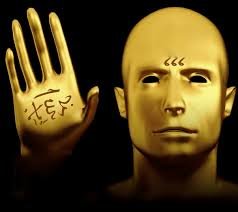 The Beast's mark on the compromised & unsaved
The Beast's mark on the compromised & unsaved
A Question of Angels
We begin today's segment with an unnamed malak or angel of extraordinary power. Few angels are named in the Bible because the focus or attention is never Yahweh's messengers but the message. True malakim (angels) are noted consistently for their anonymity. This point needs to be recalled when people present apocryphal writings to you (as you will find in non-Protestant collections) and claim they are inspired and worthy of our attention, because these writings often go to great lengths to give lists of angelic names. Be careful. One of the warnings we are given is to be wary of believers who have an unhealthy interest in angels:
"Do not let anyone who delights in false humility and the worship of malakim (angels) disqualify you for the prize. Such a person goes into great detail about what he has seen, and his unspiritual mind puffs him up with idle notions. He has lost connection with the Head..." (Col.2:18-19, NIV).
A Human Tendency to Idolatrise Angels
Given the flesh's tendency to idolatrise both living and inanimate things by giving too much attention to both human and angelic messengers, we need to raise red flags every time attention is deflected from Christ and onto other beings claiming to be 'special messengers' with this 'prophetic anointing' or that. Several times in the Book of Revelation John falls into the trap if wanting to worship angelic beings and has to be upbraided. Worship is due to Elohim (God) alone. So I want you to be careful when people present non-canonical books to you for acceptance because one thing that frequently characterises them is their tendency to both talk about, and name, lots of different angels in a way very different from the biblcal books. This is is not to deny the important ministries of angels but it is to warn believers not to give them undue prominence which true malakim (angels) strongly dislike. Only the false, fallen angels or demons crave personal attention because they want to be worshipped as gods.
Angelic Systems in False Religion
I have seen many angels in my life but not one of them has ever given me his name, nor have I ever asked for one. Most of them, when speaking to me, have used few words and none of them has ever hung around for a discussion, except one false one I have told you about several times who waxed eloquent but whom I caught out lying. The only name true malakim (angels) promote is that of the Father (Yahweh) and His Christ (Yah'shua/Jesus). All true angels point to Christ and never to themselves. Like true nevi'im (prophets), they deliver their message then obediently fade into the background so as not to rob Yahweh of His glory. Rarely do they give their names.
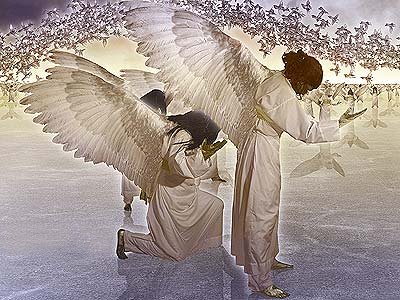 Angels are ministering spirits & we are forbidden to worship them
Angels are ministering spirits & we are forbidden to worship them
Angelic Names in Scripture and Other Writings
How many angelic names are mentioned in the Protestant canon? Of the millions of angels we know exist, only two are named: Michael and Gabriel, both important archangels (e.g. Jude 1:9; Dan.9:21). Yet go to an apocryphal book like the so-called Book of Enoch, so beloved by far too many messianics and some evangelicals, and you'll find seven mentioned. We are warned to stay clear of "myths and endless genealogies" (1 Tim.1:4) which is one of the crazes of the unspiritual. Mormonism's foundations are saturated with mythical angels like 'Nephi' and 'Moroni' as well as biblical characters like John the Baptist and Elijah who have been 'upgraded' to angel status and hand over alleged 'spiritual keys' and 'priesthood authority' to their founder, Joseph Smith. The Jewish occult practice of Kabbalism is full of angelic fables and forbidden rituals for summoning them. So if anyone starts going on about 'Raphael', 'Uriel', 'Sariel', 'Raguel', 'Remiel' or any of the numerous apocryphal 'angels', pay no attention - stop listening or reading such material. All of this detracts from what matters - the pursuit of Christ to whom we can, and must, go directly.
The Nature of Post-Mortem Reality
Today's segment raises some important theological questions. One thing it does, along with the rest of the Book of Revelation, is underline a two-stage post-mortem reality. Listening to most Protestants you would think there was only one. Firstly, those who belong to the Messiah, when they die, to be "with Him" as Paul tells the Philippians:
"For to me, to live is Christ and to die is gain. If I am to go on living in the [physical] body, this will mean fruitful labour for me. Yet what shall I choose? I do not know! I am torn between the two: I desire to depart and be with Christ, which is better by far" (Phil.1:21-23, NIV)
The Moment of Resurrection
Then, at last, Yah'shua (Jesus) will appear, as heaven and earth come together in a great fresh act of New Creation. That will be the moment of resurrection, the moment the dead have been waiting for. What is resurrection? Resurrection is the abolition of death itself, giving Yahweh's people new, immortal physical bodies to live in Yahweh's new world. That is the Great Hope of both ancient Judaism and of classic Christianity and Messianism.
Half the Story Told
This is not, however, a message you will commonly hear coming out of Western and Evangelical Christianity in particular who talk only of a one-step post-mortem reality: when you die, you go to Heaven (or Hell) and that's it! It is a tragedy that so much of Western Christianity (and not just the 'evangelical' wing but also the 'liberal' one) has slipped its New Testament moorings in this most vital of areas and has contented itself with just telling half the story.
The Three-Stage Post-Morten Reality of Revelation 20
'Heaven' is not, however, the final destination. Our future is not that of disembodied spirits in some sort of whispy 'alternative reality'. As Revelation 20 makes abundantly clear, we are faced with quite a different sort of problem. It's hard enough to get millions of traditional Christians to accept a two-stage reality following death, with physical 'resurrection' back here on the earth as the second of two stages. But Revelation 20 goes further, as Messianic Evangelicals have been pointing out for decades: it envisages a three-stage reality that blows the minds of most believers who have never really properly considered what today's text says. So what are these three stages, according here to the apostle John who wrote Revelation?
- 1. First, the resurrection of the souls crying for justice symbolically located under the Altar (Rev.6:9);
- 2. Second, the resurrection of some, not all, believers to share a 1,000-year reign with Christ; and then,
- 3. Thirdly, the final resurrection of the rest of all people - of the wicked to hear and face their condemnation, and of Elohim's (God's) people to hear and face "the verdict (justification) that leads to life" (Rom.5:18, KNT).
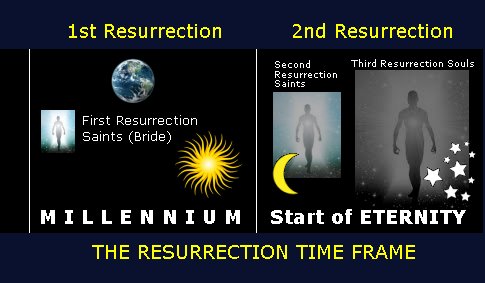
The Book of Revelation is Unique in Its Extra Detail
No other writing, Jewish or Christian/Messianic, makes any mention of this 'double' or 'two-stage' resurrection, let alone the surrounding events, which makes the Book of Revelation account of these things critically important to understand and incorporate into our belief system. Therefore your attention now is urgently required, please, and to please spend time afterwards taking a close look at our 'Hell' website that devotes a lot of effort to clarifying these matters.
The Three Interlocking Problems
There are three interlocking 'problems' which are made considerably more confusing for modern readers by John's kaleidoscopic imagery:
- 1. First, we are naturally puzzled as to why, after the Beast (Antichrist) and False Prophet have been thrown alive into the Lake of Fire, there seems not only to be a delay before Satan joins them there, but also a temporary respite in which he is let out of prison one last time to do his worst before being finally overthrown. Why the delay, and why must he again be released?
- 2. Second, what is John referring to, in real, historical terms, when he speaks of the thousand years in which these 'first resurrection' people reign with the Messiah? How does that relate to the subsequent picture of the New Jerusalem in chapters 21 and 22? Is the one a metaphor for the other? Are they describing, or at least denoting, two quite different things? Or what? (It's here all the confusion arises in interpreting these last three chapters); and
- 3. Third, how then does this 'first resurrection' relate to the second one? Now, whilst John doesn't call it 'the second resurrection', his previous use of a 'first resurrection' clearly implies it. What sort of story can we tell, or should we tell, that will bring out the reference, the meaning and the flavour of these very puzzling six verses?
The Difficulty With Doctrines Backed by Only One Passage
To answer these important questions, we have to take into account the whole counsel of Scripture, let Scripture interpret Scripture, and not look at Revelation in isolation. Looking at the Book of Revelation detatched from the rest of the Messianic Scriptures (New Testament) will not yield all the answers we want. To begin with, let's note that, just as 1 Thessalonians 4 is the only passage to describe anything remotely like a 'rapture' (and as I have been teaching you for years, this doesn't at all describe the 'rapture' as popularly understood in Dispensationalism), and just as Revelation 16:16 is the only place in Scripture to mention a final great battle at 'Armageddon', so Revelation 20 - the passage now before us - is the only passage in Scripture where a 'Millennium' is even mentioned.
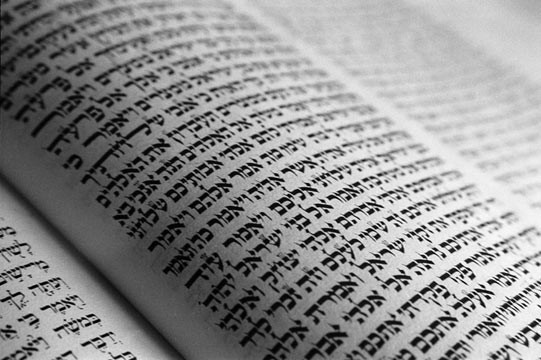 The whole counsel of Scripture must resolve difficult doctrines
The whole counsel of Scripture must resolve difficult doctrines
The Danger of Speculative Prophecy and Interpretation
The temptation here, which thousands of improperly informed evangelical and messianic teachers and preachers have fallen for, is to indulge in speculative prophecy and interpretation by snapping up these and other snippets, taking them (usually) out of their actual contexts, and constructing a quite different, unbiblical world-view in which they play a far more important rôle than they do in Scripture itself. That alone ought to make us wary of following where the interpreters lead - quite apart from the dualistic framework within which such 'prophecy-interpretation' is regularly set, with the wicked earth (in this false model) being 'thrown away' while 'the saints' remain 'safe' in heaven, and without any sense of the renewal of creation, so important in this book, as also in the four Gospels and Paul.
Explaining Dualism
To remind those of you who may have forgotten what theological 'dualism' is, let me explain. Dualism is the idea that all of life can be separated into two main categories: the sacred and the secular, or the heavenly and the earthly. This fragmented vision of reality puts all 'spiritual' things into the 'sacred' or 'heavenly' theological box and all 'earthly' things in the 'secular' category or box. And this is the critically important point - please underline it many times with a thick metaphorical marker-pen: THE BIBLE IS NOT DUALISTIC - that is the Gnostic heresy that infiltrated Christrianity very early on - that sees everything to do with the earth as 'evil' (and therefore a world to be permanently escaped from) and heaven - the world of disembodied spirits - as the permanent place to be escaped to...the operative verb here being 'escape'. Dualism wants us to 'run away', as quickly as possibly, from the place Yahweh-Elohim designed for us to be in, grow in (even though it's a fallen world for now), and one day inherit when it has been cleansed and glorified.
 The brain has two complementary, not antagonistic, halves
The brain has two complementary, not antagonistic, halves
Exposing the Gnostic Error
Satan says 'Run!' from Yahweh's world that he (Satan) has subsequently corrupted, thanks initially to Adam and Eve, but we are to do no such thing. We are to stay put until our temporary removal in death. Rather than abandon the physical earth forever and yearn for a disembodied spirit-world as the consummate goal, heaven and earth, we're told, are to be permanently joined together in the Resurrection World-to-Come, and that's what we are to long for! If the Gnostic or Dualistic vision is the correct one, then there is no need for any physical resurrection at all. If you can grasp that, so many of the false theologies that have caused so much confusion in the Body of Christ, immediately fall by the wayside and can be abandoned for good. This includes any supposed 'need' for a 'Rapture' which is another form of escapism or 'run-away-ism'. If 'escape' were the main thing, then those alive when Christ returns would not be transformed 'in the twinking-of-an-eye' (1 Cor.15:52) to remain on the new earth but would happily depart their physical bodies and head home to 'heaven'. Indeed, there would be no point of a Second Coming at all whether by Messiah or by the Qodeshim (saints, set-apart ones) other than to collect the righteous survivors of the Great Tribulation and escort them back 'home' to heaven in the way Rapturists and others teach. Dualism negates the whole Bible Story! I would even go so far as to say that when properly analysed, it is seen to be a denial of the cross too. That's the magnitude of the lie that most of Christendom has swallowed thanks to Catholicism.
Those Pesky 'Interruptions'
Which brings us to the important matter of the temporary binding of Satan. Wouldn't it have been tidier, you may ask, if the battle in chapter 19 had seen off all Yahweh's adversaries in one go? Nobody would have grumbled, I suspect, if Satan had been part of the defeated Enemy armies, and the book had proceeded straight on to the New Jerusalem. But the Book of Revelation is seldom tidy in the limited way of our fleshy understandings and desires. Have we not noticed, twice already, that the sequence we expected is interrupted? Think back. Do you remember the Synopsis of Revelation 6-18 that appeared as an Appendix at the end of every study when we were looking at those chapters? Let me remind you of it. I have marked the two interruptions as with → red arrows on the website):
The Seven Seals
- 1. White horse - military aggression
- 2. Red horse - bloodshed
- 3. Black horse - famine
- 4. Pale Green/Blanched/Pallid/Sickly-looking horse - disease, epidemics
- 5. Persecution & prayer
- 6. Tremour & terror
→ INTERLUDE ('PAUSE') I (Ch.7)
(The 144,000 Redeemed)
- 7. Silence in heaven, listening to prayers which are then answered in a final catastrophe: a severe earthquake I
The Seven Trumpets/Shofars
- 1. Scorched earth
- 2. Polluted sea
- 3. Contaminated water
- 4. Reduced sunlight
- 5. Insects and plague (for five months) (1st Woe)
- 6. Oriental invasion (200 million army) (2nd Woe)
→ INTERLUDE ('PAUSE') II (Ch.10-11)
(The Malak with the Little Scroll)
(The Two Witnesses)
- 7. The Kingdom comes, the world is taken over by Yahweh & Yah'shua (Jesus) after a severe earthquake II (3rd Woe)
INTERLUDE III (Ch.13-14)
(The First & Second Beasts)
(The Lamb & the 144,000)
(The Messages of the Three Malakim)
The Seven Bowls/Vials
- 1. Boils on the skin
- 2. Blood in the sea
- 3. Blood from the springs
- 4. Burning by the sun
- 5. Darkness
- 6. Armageddon
- 7. Hailstorm (OB 368:11-12) and severe earthquake III, leading to international collapse
POSTSCRIPT (Ch.17-18)
(Babylon the Great & the Bride)
Pausing to Seal the Elect & Hand Over the Scroll to John
First, in the sequence of seals, we had to pause between the 6th and 7th seals (I called them 'Interludes') - judgment was suspended while the suffering and martyred people of Elohim (God) were 'sealed' (chapter 7). Then, between the 6th and 7th shofars or trumpets, we again had to pause, this time while John was given the scroll from which he prophesied about Yahweh's witnesses. Those people were seen under the image of the two, like Zerubbabel and Joshua, the melek (king) and the cohen (priest), and like Moses and Elijah, the nevi'im (prophets), through whose death and resurrection the world would come to glorify the true Elohim (God) (chapters 10 & 11).
Diffficult, but Important, Questions
Those were the two 'unexpected pauses', and now we have another one. Interesting, isn't it? Again, we note, it concerns the suffering and martyred people of Elohim (God), who are again celebrated as the true witnesses, the priest-kings who share the Messiah's rule (verse 6). The tavnith or pattern repeats...three times. So why is Satan given 'extra time', as it were? And why must the qodeshim (saints, set-apart ones) endure yet another round of his predations? Before we answer those questions, let me ask you some other ones:
- 1. What's the difference between a resurrected and an unresurrected person?
- 2. Will the millennial earth only be inhabited by the martyrs and the elect Remnant from all the ages past and present?
- 3. If this is still a physical world, will men and women continue to be able to have children? And if so,
- 4. Will they be born as resurrected beings or unresurrected beings?
- 5. Or will the population remain static for 1,000 years?
- 6. Or will the population continue to grow as in previous æons (ages)?
 What will resurrected humans be like?
What will resurrected humans be like?
No doubt you can think of other questions that need to be answered too but these will do for now. I'm going to leave these questions largely unanswered, even though I have answered them before elsewhere, so that you can arrive at your own scripturally-reasoned answers. I don't want to always spoon-feed you. Start wielding your own intellectual cutlery!
Why Isn't Satan Now Cast into the Lake of Fire?
Instead, let's answer the first of the two big questions I asked earlier on, namely, why wasn't Satan cast into the Lake of Fire along with the Beast and False Prophet? To answer that question, we must remember that Heylel (as he was originally called when he was an Archangel), Lucifer or Satan was initially a member of the Divine or Heavenly Council. Though he fell from his position of authority, he can (and still does, by Yahweh's permission), play a rôle. And if you'd like an example of this from contemporary fiction, consider the rôle Tolkein (1892-1973) gave Gollum, right up to the climax of The Lord of the Rings. I believe Tolkein, who was a Catholic Christian, was aware of exactly this kind of parallel - remember he and Anglican C.S.Lewis (1898-1963) (who wrote the Narnia stories that I spoke about last week) were both contemporary writers at Oxford (at around the time I was born) and were good friends.
Satan as a 'Public Prosecutor' Gone Rogue
Satan's job was always to accuse where accusation was due (which is why he is called haSatan or 'the satan', meaning 'the accuser'), to make sure (as an effective Director of Public Prosecutions) that nothing reprehensible went unreprehended. And so, one last time, he must play that rôle, even though as before he will pervert it and try to deceive and accuse in all directions, warranted or not (v.8). He must ultimately do the worst he can, so that when he is defeated there will be no last tiny remnant of suspicion that anything worthy of 'accusation' has been left unaccounted for. He must be allowed a final moment to flail around with his lies and accusations, so that in his overthrow it will be clear beyond the slightest doubt that "there is now no condemnation for those who are in Messiah Yah'shua (Christ Jesus)" (Rom.8:1, NIV). Like a boxer staggering to his feet to face the last punch, he must come up one more time, even if only to be knocked out cold on the canvas for ever. That's why Satan must be let out one last time.
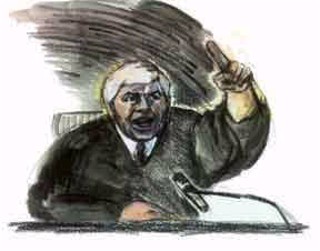 Satan is like a public prosecutor in a trial
Satan is like a public prosecutor in a trial
Difficult but Important Questions
This scenario begs a number of important questions which I am going to throw out at you to chew over for a couple of weeks or so before we come to make an in-depth study of the Millennium to try to understand how believers have interpreted (and misinterpreted) the artifically divided chapter 20.
- 1. Who exactly will live during the Millennium for Satan to tempt one last time right at the end?
- 2. Who of these is He going to be accusing?
- 3. And will anyone be found guilty? Remember, there's going to be a thousand years of generations (around 33 in all, assuming a generation is 30 years) to accuse;
- 4. Will they all be resurrected persons?
- 5. Or will there be no further generations - just the original martyrs?
- 6. Will the population be the same at the beginning of the Millennium as at its end when Satan is released?
- 7. What are we going to be doing during that 1,000 years?
- 8. Can - and will - the immortal resurrected Elect, have children?
- 9. What does a resurrected person look like? A lot of theological assumptions come into play;
- 10. And if they are able to have children, will they be born immortal or mortal?
- 11. If mortal, when do they get to be resurrected? At birth? At the end of a fixed number of years (e.g. 70)?
- 12. Will there be any sinning during the Millennium?
- 13. We know there will be judges, so who will they be judging, and for what?
- 14. Can immortal beings sin, even without demons around to tempt and goad them (because they're locked up for 1,000 years)?
- 15. And what is the consequence to them - practically - for sinning? Remember, malakim/angels, who are immortal beings, were able to sin and indeed rebelled.
- 16. How do resurrected humans compare to immortal angels? We're told, for instance, that whereas angels are a little higher than us now, later the resurrected will be a little higher than angels (Heb.2:7,9), which suggests resurrected human beings may be like them in some way.
The Key Questions Summarised
These are really hard questions, not just for the dualists who think they're going to be 'spirits in heaven for ever' but for all of us. So I am going to leave these questions, for the most part, unanswered for now in order to stimulate some independent thinking on your part. Just remember, whatever you conclude must agree with the whole counsel of Scripture, not just cherry-picked passages here and there. Of critical importance will be a clear cut answer to the question:
- A. What will a resurrected person be like?
- B. Will they be able to reproduce? (We know angels can, even though they were forbidden from doing so, because of the race of giants or nefilim they created);
- C. Will their children me mortal or immortal?
Who Will Be Ruling Who?
Let's get back to the time before Satan is released, because before his return to once again wreak havoc, the reign of Messiah - with and through the faithful Torah-obedient Elect believers - must be established by the first resurrection. And here are some other important questions for you to ask yourselves:
- 17. Who will be the Elect be ruling (since they are kings and priests)?
- 18. Will there be other (non-elect) survivors of the Great Tribulation?
- 19. And if so, who?
- 20. And if the Torah-disobedient and the unsaved wicked aren't to be resurrected until after the Millennium, who else could there possibly be to rule?
There your answers to the first set of questions will become critical.
Are the Only Millennial Inhabitants the Beheaded Martyrs?
John helpfully itemises those of the first resurrection not just as martyrs (as opposed to other believers who were not martyred) but specifically as those who had been beheaded for their witness. This has led some literalists, rather naïvely in my opinion, to conclude that earth's first resurrection Millennial inhabitants will only be martyrs, and specifically those beheaded in the last generation! That would exclude all those martyred by other means (by hanging, crucfixion and any other horrible method you can think of). That would exclude the very writer of the Book of Revelation, John, himself who was not martyred (even though traditions says the enemies of the cross tried to boil him alive in oil but failed to kill him)! It would exclude those original apostles not executed by beheading unlike the apostle Paul but even he would be excluded because he was not of the last generation! It would also exclude Peter (who was crucified upside down). Indeed such a narrow, literalist interpretation (and I personally know of one person who holds this view) would exclude all the martyrs from all the generations before the last one; and that would mean that all those resurrected qodeshim (saints, set-apart ones) returning with Christ on symbolic white horses would have to be sent away to goodness knows where because they wouldn't qualify for the Millennium which means they would have to be unresurrected too and left in suspension somewhere. The silliness of such a narrow, literalist interpretation soon becomes apparent and again reminds us of the theological cul de sac's (dead-ends) we can end up in if we get too literal.
An Example of Deliberately Inserted Code Words in John's Wrintings
This means we are going to have to look at this portion of the text in the same way as the rest of the Book - symbolically. And to do that, we have to put our historian's spectacles on again and ask ourselves what this passage of Scripture would have meant to first century believers hearing this message in their own situational context? What could John be possibly hinting at that would make sense to the Seven Assemblies of Asia Minor (chapters 2 & 3) to whom the Book of Revelation was originally written, which we can't make sense of 2,000 years later? How would someone in Ephesus or Laodicea have understood it? And if, as we know, persecution was going on at the time - and if, as we know, many of the messages are coded so as not to provoke unnecessary extra persecution, especially by John whom we know uses a code when, for example, in his second epistle (which chronologically was was written at around the same time as the Book of Revelation though a little after it) he addresses his epistle as "the elder" and "to the elect lady and her children" (2 Jn.1:1, NRSV).
A First Century Explanation of the 'Beheaded'
Given that Revelation is addressed to the true believers whose "citizenship is in heaven" (Phil.3:20), that's to say, in Yah'shua's (Jesus') Kingdom; and given that it was Roman citizens alone who were executed by beheading (better to be executed and die instantaneously rather than endure a protracted, torturous execution like crucifixion, for example), then the reason for the 'beheaded' symbolism becomes more apparent. Those who are worthy of the first resurrection are all those who were not only literally martyrs in the last generation, but also those willing to die for Messiah, like many of the martyrs in northern Nigeria who are being skinned alive today by their adversaries from the 'Religion of Peace' before being murdered, and in all generations.
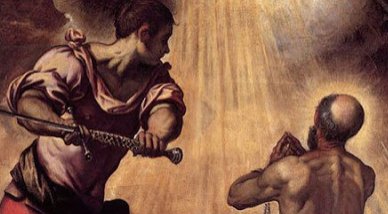 Paul's execution - who are the 'beheaded' martyrs?
Paul's execution - who are the 'beheaded' martyrs?
A Question of Citizenship
You see, if we follow a literalist approach ('beheaded-last-generation-martyrs-only for the Millennium') then we must interpret in a way contrary to John's normal line by suggesting there is a radical difference between one set of martyrs and another based solely on the time and method of execution, which is surely offensive to any moral sensibility. Do you believe that? I don't. There is no evidence whatsoever in Scripture that one kind of martyrdom is 'holier' than another. Such a notion is similar to the outrageous Calvinist claim that God has decided in advance who will be saved and who will not, before creation itself. No, the reason John uses 'beheading' is to underline the martyrs' particular, heavenly citizenship, and nothing else; and the only kind of citizenship apart from the heavenly kind that would have been understood by the first century Christians/Messianics living in the Roman Empire would have been Roman citizenship, which Paul uses to his advantage many times in the story of his ministry (e.g. Ac.22:25-29; 23:27), which as we have already seen elsewhere in these studies, comes to represent all worldly imperial systems in every age. Those who serve the 'Roman', 'Babylonian' or 'Nimrodian' imperial system (then, as today) over and above Yahweh's Kingdom, in order to save their skins, are not worthy of the Millennial inheritance. That is what I believe John is telling us here - it is entirely consistent with the overall theme of the Book of Revelation and with the whole Bible.
Is the 1,000 Years Literal or Symbolic?
But should we, as some (like the Preterists) do, take the 1,000 years symbolically as well? Here we must be careful. Before I answer that, let me remind you that some things in the Book of Revelation are quite literal, like Christ, the Antichrist, the False Prophet, etc.. Also, as we have seen, there can be many layers to symbols. Thus 1,000 can, and does indeed, symbolise new spiritual beginnings in the abstract. But it is just as likely to be literal. Thus when I became literally 21 years old, then (in the British tradition) I simultaneously 'became of age' - an adult (an abstract idea).
Understanding the Use of Language
There are, clearly, two resurrections with a space of time between them, in the same way that separations are requered for sheep and goats, the righteous and the wicked - the same way there were spaces of time (i.e. a chronological sequence of events) between the three series of Seven Woes. True, some numbers are deliberately rounded off into prophetic numbers as with many of the genealogies, ages of kings, etc., and it is important that we are reminded of these things too. I frequently, for example, speak of the generation of Christ and the apostles as being '2,000 years ago', and have done so for many years, because I am being approximate and because 2,000 is a nice round number easier to remember. I am not seeking to deceive, nor am I being 'inaccurate' because I'm explaining to you why I do this. Besides, I'm not pointing back to a specific year but to the approximate span of a generation. Likewise, if I say, 'Hitler invaded Poland in 1939' I am not being deceitful even though Hitler did not invade Poland by himself, nor was he even a front-line combattant. He simply represents the nazi imperial system as its leader that undertook an invasion. He made the decision to invade, he didn't invade himself. Understanding the way language is used '2,000' years ago, in a culture very different to our own, is important to interpreting Scripture. Hence the need for careful scholarship and for congregations to have knowledgeable teachers. One could, if one wanted to, become even more extremist in literalism by saying all the inhabitants of the Millennium will be headless. You get my point, I hope.
When the Year 1000 Arrived People Thought the End Had Come
Here's another example of what I mean. There were some believers around the year AD 1,000 in Catholic Europe, who supposed they were about to see the end of the 'millennial age' but as with other such speculations the date passed without significant eschatological events taking place. Those who suddenly repented on 31 December AD 999, fearful of imminent judgment, stopped repenting when 1 January 1001 rolled along, and returned to sinning, and in some cases were disillusioned as often those who misinterpret Scripture are. Their mistake, which remains the Catholic error to this day, is that the Millennium began with the first advent of Christ, or shortly thereafter.
AD 1000
1,000 is Both Literal and Symbolic
Certainly Preterists believe the Millennium began around the time of the resurrection. They also believe, as N.T.Wright and many others believe (I don't), that the 1,000 years could equally well be a longer or shorter period of time. And whilst I am willing to intellectually run with that provided the margin on either side isn't too large (in the same way I do not believe that Yah'shua's/Jesus' body lay in the tomb for 3 full days or for exactly 72 hours), my experience tells me that Yahweh can, and often does, use numbers with pinpoint accuracy as far as actual time is concerned. I know I have told you that just before I contracted my first marriage, Yahweh spoke to me and told me that my marriage would last 7 years. I didn't believe Him (because I didn't want to) but my marriage lasted exactly 7 years to the day. This was not a conditional prophecy, moreover. So I, for one, hesitate to dismiss the idea that the 1,000 could be both symbolic and literal and I have stood by this conviction consistently throughout my ministry. But I am willing to be flexible, within limits. I do not, for reasons I will be giving later, believe the first and second resurrections occur side-by-side separated by minutes or hours. That would make no sense whereas pauses and breathing spaces are a consistent reality of Yahweh's spiritual dealings throughout the Scriptures. I have named two of these already today.
The Preterist Untruth That We Live in the Millennium Today
Where I do agree with N.T.Wright, though, is in rejecting the claim by some that the 1,000 years is the "age of the church" (because I don't believe there is such a thing [1]) but not necessarily for the same reasons, and it's for basically the same kinds of reason I am not a Preterist). Nobody who is aware of 'church history' would suppose for one moment that there has been no satanic attack, no deceiving of the nations (or of the Messianic Community/Church itself), no wickeddness or no warfare, during that time. If you know any history of the last 2,000 years at all, you will know that idea is ludicrous, given all the evil that has been done and is still being done to this very day. We're hardly living in the time prophesied by Isaiah (chapters 11 & 16) where the wolf is lying down peacefully with the lamb, a child is able to handle a poisonous snake unharmed, and so on. And even if you're not a history buff, you only have to look around you at what is happening today, to see that that proposition is untrue. The whole world is saturated with lies and believers are being martyred for their faith, a scene reminiscent of the first 19 chapters of the Book of Revelation, but not Chapter 20. Christ is not reigning on this planet...yet...save in the hearts of true, spiritually-regenerated believers who are a tiny minority in terms of the global population.
All Authority is Given to Messiah
Now it is true that there is a sense in which Messiah is already reigning on the earth so I'd like to finish today by examining a couple of potentially many passages on the subject as these are frequently quoted by Preterists and others in defence of their beliefs. At the end of the Gospel of Matthew, shortly before the ascension, Yah'shua (Jesus) said to His talmidim (disciples):
"All authority in heaven and on earth has been given to Me..." (Mt.28:18, NIV).
By way of illustration, Yahweh has likewise given me autonomy and authority over my own body until the end of the æon (age) but I live in a world where the state in many countries demands the authority (for example) to forcibly vaccinate me or (in the case of communist China) compel women to have abortions if they have more than the state-allowed number of children (originally 1, now 2). There is therefore, at times, a clash between the authority of the individual and the authority of a governmental power. Likewise, Christ has been given all authority by the Father over everything and everyone; nevertheless, there are individuals, groups and governments who oppose that authority because they are yet in rebellion. And until those individuals, groups and governments are subdued in the way the Book of Revelation is showing us they will be, the final realisation of Christ's authority, practically-speaking, will be delayed for as long as man is granted the freedom to choose in opposition to His authority, which is a fixed period of time that ends when Christ returns. This forced assumption of outward authority is metaphorically described as 'putting everything under him' and occurs at the end of the 'end times'.
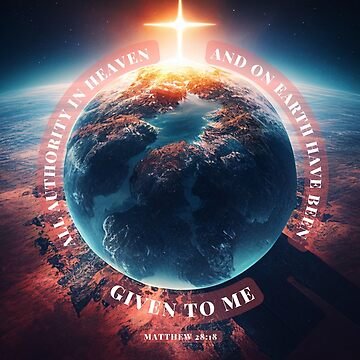
Putting Everything Under Messiah's Feet
Thus Paul wrote to the Corinthians, saying:
"Then the end will come, when [Yah'shua/Jesus] hands over the kingdom to Elohim (God) the Father after He has destroyed all dominion, authority and power. For He must reign until He has put all His enemies under His feet. The last enemy to be destroyed is death. For He 'has put everything under His feet.' Now when it says that 'everything' has been put under Him, it is clear that this does not include Elohim (God) himself, who put everything under Christ. When He has done this, then the Son Himself will be made subject to Him (Yahweh) who put everything under Him, so that Elohim (God) may be all in all" (1 Cor.15:24-28, NIV).
Conquest of the Physical Dimension
There is, however, for now, still a separation between the earthly and the heavenly, while Messiah is reigning in the spiritual dimension, and it will remain that way until He conquers all - rebellious individuals, the Imperial System of Rome/Babylon, the Antichrist and False Prophet (when they come), and finally Satan and his demonic hosts. They were all defeated '2,000' years ago at the cross in the spiritual or heavenly dimension but still remain in charge on earth so long as there are humans here sinning and judgment has not been completed. Also, the full compliment of souls must have time to be born on earth. Yah'shua (Jesus) could have stepped in, theoretically-speaking, right after the resurrection, since He won both the power and authority to do so at Calvary, and Has received all power and dominion from the Father until that day when He returns it to the Father, as Paul said, so that that "Elohim (God) may be all in all" which has not happened yet (1 Cor.15:28, NIV). At that point Christ stops reigning and the Father takes over. Yet He has restrained Himself from exercising that authority in order to fulfill His Father's mitzvot (commandments) spoken through the nevi'im (prophets), giving grace to man that he might yet repent - another 2,000 years of grace following His victory on the cross.
The Relationship Between Grace and Judgment
Yes, as John says, the martyrs are already reigning with Messiah, but they are yet in Heaven and have not returned to earth on those metaphorical white horses with the mandate to rule with Him on earth. And Yes, as Paul said to the Ephesians:
"And Elohim (God) raised us up with Christ and seated us with Him in the heavenly realms in Messiah Yah'shua (Christ Jesus)..." (Eph.2:6, NIV).
but notice that His, and our, 'reigning' is practically only in the heavenly realms for now, not the earthy quite yet. We do not have power on earth yet, and that qualification is made in the following verse:
"...in order that in the coming æons (ages) He (Yahweh) might show the incomparable riches of His grace, expressed in His kindness to us in Messiah Yah'shua (Christ Jesus)" (Eph.2:7, NIV).
(Oh, and would you also note, that when Christ ceases reigning, we will too, because our reigning is with Christ).
Another reason for the delay, then, is so that we can come to understand Father Yahweh's generosity toward us, giving humanity every opportunity through 'extra time' to repent. Grace must first be exhausted before Final Judgment is permitted to 'call time', saying, 'enough if enough'!
When Satan Was cast Out of the Heavenly Dimension to Earth
There is another way we can look at this too, and that concerns the difference between the 'eternal' and the 'linear time' view, if I can call it that. Let me explain. The binding of Satan in verse 2 is said to have already been accomplished, which, since he is a spiritual being, means in the spiritual dimension. That's why he was 'cast out of heaven' to earth metaphorically-speaking in chapter 12:
"So the great dragon was cast out [of heaven], that serpent of old, called the Devil and Satan, who deceives the whole world; he was cast to the earth, and his malakim (demonic angels) were cast out with him" (Rev.12:9, NKJV).
Conditional Authority
It is for this reason that Yah'shua (Jesus) was able to expell demons from people (Mt.12:29) and why His true talmidim (disciples) did the same, and still can, because that authority took immediate effect (for us, at any rate) upon Messiah's atoning death and resurrection. Nevertheless this authority given to true believers is not absolute but conditional. If the Enemy has legal grounds to torment a sinner, He still can. If the sinner calls upon Christ for deliverance, then His ministers can cast out demons. So in spite of Yah'shua (Jesus) having 'bound' Satan as early as Matthew 12, Satan was still able to work through Judas and others, for example, to accuse Yah'shua (Jesus) and bring about His death. But perhaps what we are seeing in Revelation 20 is the cosmic version of that story. Either way, the practical realisation of that authority is limited by various things, not least man's free agency granted to him until the Final Judgment.
Past, Present and Future
If at times I use the word 'perhaps' to describe the details of these grand things know it is because I don't want to be too dogmatic about what nobody yet fully understands. The way the Son of Elohim (God) interacts with time is a great mystery for us because He is at the same time in it (as an incarnate human being, like us) but also outside it (as Elohim/God, which we are not). We understand (though don't understand yet all the mechanics) that Messiah's atonement, though made in a moment of time 2,000 years ago, reaches or affects both the past and the future simultaneously, so that men and women of all æons (ages) may be blessed by His cosmic resurrection power released to them at Calvary. I believe His 'reigning' needs to be seen in the same light. What we do know, because the Book of Revelation expresses it so clearly, is that the Lamb has won and we are called to ourselves live in the power of that victory through emunah (faith) and patience. This we do know. There is a sense, therefore, that Revelation 20 is talking about past, present and future simultaneously. Therefore Paul was able to say to the Romans:
"I consider that our present sufferings are not worth comparing with the glory that will be revealed in us. The creation waits in eager expectation for the sons of Elohim (God) to be revealed. For the creation was subjected to frustration, not by its own choice, but by the will of the One who subjected it, in hope that the creation itself will be liberated from its bondage to decay and brought into the glorious freedom of the children of Elohim (God).
"We know that the whole creation has been groaning as in the pains of childbirth right up to the present time. Not only so, but we ourselves, who have the bikkurim (firstfruits) of the Ruach (Spirit), groan inwardly as we wait eagerly for our adoption as sons, the redemption of our bodies. For in this hope we were saved. But hope that is seen is no hope at all. Who hopes for what he already has? But if we hope for what we do not yet have, we wait for it patiently.
"In the same way, the Ruach (Spirit) helps us in our weakness. We do not know what we ought to pray for, but the Ruach (Spirit)...intercedes for us with groans that words cannot express. And He who searches our hearts knows the mind of the Ruach (Spirit), because the Ruach (Spirit) intercedes for the qodeshim (saints, set-apart ones) in accordance with Elohim's (God's) will" (Rom.8:18-27, NIV; cp. 1 Cor.15:20-28).
The Creator Wins
The ultimate winner is, of course, the Creator-Elohim (God), Yahweh, who does so to defeat and abolish death itself and so to open the way to the glories of the renewed creation. That's what matters, and this much we can understand, and do understand when we have our eyes opened through regeneration by the Ruach haQodesh (Holy Spirit).
Conclusion
We'll finish chapter 20 next week or the week after, Yah willing, in which we shall be looking closely at Satan's final release at the end of the Millennium, his final defeat and banishment, and the Great White Throne Room Judgment and Resurrection. Then we'll pause, using what we have learned up to now, to consider how the Millennium is so misunderstood by different groups before resuming with chapter 21. Be blessed in your walk with Him, so until then, my prayer is that Yahweh give you His increase of spiritual riches through Yah'shua the Messisah (Jesus Christ), our Master (Lord). Amen.
Continued in Part 71
Endnotes
[1] The distinction is a fine one since the idea of 'Church' (from the Latin circe meaning 'circus' is named after the pagan cereal god Ceres) is Roman in origin. The 'Messianic Age' began '2,000' years ago with the arrival of Messiah Yah'shua (Jesus) as the legitimate King of Israel, transforming 'Israel' into 'Messianic Israel' (but not into a 'church'). Protestants themselves are not agreed when their 'church' began, with the majority believing it 'started' at 'Pentecost' and others at some time before that during Christ's ministry (e.g. at Caesarea Philippi).
Acknowledgements
[1] Tom Wright, Revelation for Everyone - The New Testament for Everyone Commentary Series, Vol.19 (SPCK, London: 2011)
[2] E.W.Bullinger*, Commentary on Revelation (Kregel Classics, Grand Rapids, Michigan: 1984)
[3] David H. Stern, Jewish New Testament Commentary (JNT Publications, Clarksville, Maryland: 1992)
[4] ESV Study Bible (Crossway, Wheaton, Illinois: 2011)
[5] The NIV Study Bible (Zondervan, Grand Rapids, Michigan: 1995)
[6] Ed. J.R.Dummelow, A Commentary on the Holy Bible (MacMillan, London: 1909)
[7] David Pawson, Unlocking the Bible: A Unique Overview of the Whole Bible (Collins, London: 2007)
*E.W.Bullinger was a brilliant Anglican clergyman and scholar whose works merit careful study by serious students of the Bible. He was, however, seriously in error in at least three main areas, namely, (1) he believed the 'Church' has been raptured before the Book of Revelation opens, (2) he believed that the 7 churches in Revelation 2-3 are 7, literal Jewish churches or assemblies yet to come, and (3) he believed in a pre-tribulation, pre-millennial rapture.
APPENDIX I
SYNOPSIS OF REVELATION 19-22
- C. The Far Future
- C1. Chapter 19
- C1.1. Yahweh's Victory Celebration (19:1-10)
- C1.2. The Beast Defeated (19:11-21)
- C2. Chapter 20
- C2.1. The Millennial Reign (20:1-6)
- C2.2. The Final Judgment (20:7-15)
- C3. Chapter 21:1-21
- C3.1. The New Heaven & Earth (21:1-5)
- C3.2. The New Jerusalem (21:6-21)
- C4. Chapter 21:22-22:21
- C4.1. New Jerusalem (21:22-22:7)
- C4.2. 'I am Coming Soon' (22:8-21)
APPENDIX II
THE 7-FOLD DIVISION OF REVELATION 19:11-21:2
1. Parousia
(19:11-16) |
King of kings, Lord of lords (and logos/davar = 'word')
White horses, blood-stained robes |
2. Supper
(19:17-18) |
Angelic invitation to birds...
...to gorge on corpses |
3. Armageddon
(19:19-21) |
Kings and armies destroyed (by 'word' = logos/davar)
Two beasts thrown alive into the lake of fire |
4. Satan
(20:1-3) |
Bound and banished to the 'abyss' (deep/bottomless pit)
But for a limited time |
5. Millennium
(20:4-10) |
Saints and martyrs reign (first resurrection)
Satan released for a short season & thrown into the lake of fire |
6. Judgment
(20:11-15) |
General (second) resurrection of 'the rest'
Books/Scrolls and 'book/scroll of life' opened |
7. New Creation
(21:1-2) |
New heaven and earth
New Jerusalem |
 Click the image for the whole Series
Click the image for the whole Series

 V449
V449
|


